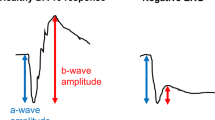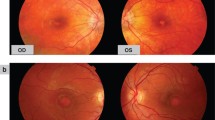Abstract
Objective To assess the frequency of negative waveform electroretinograms (ERGs) in a tertiary referral center. Design Retrospective chart review. Participants All patients who had an ERG performed at the electrophysiology clinic at Emory University from January 1999 through March 2008 were included in the study. Methods Patients with b-wave amplitude ≤ a-wave amplitude during the dark-adapted bright flash recording, in at least one eye, were identified as having a “negative ERG”. Clinical information, such as age, gender, symptoms, best corrected visual acuity, and diagnoses were recorded for these patients when available. Results A total of 1,837 patients underwent ERG testing during the study period. Of those, 73 patients had a negative ERG, for a frequency of 4.0%. Within the adult (≥18 years of age) and pediatric populations, the frequencies of a negative ERG were 2.5 and 7.2%, respectively. Among the 73 cases, negative ERGs were more common among male than female patients, 6.7% versus 1.8% (P < 0.0001). Negative ERGs were most common among male children and least common among female adults, 9.6% versus 1.1%, respectively, (P < 0.0001). Overall in this group of patients, the most common diagnoses associated with a negative ERG were congenital stationary night blindness (CSNB, n = 29) and X-linked retinoschisis (XLRS, n = 7). Conclusions The overall frequency of negative ERGs in this large retrospective review was 4.0%. Negative ERGs were most common among male children and least common among female adults. Despite the growing number of new diagnoses associated with negative ERGs, CSNB, and XLRS appear to be the most likely diagnoses for a pediatric patient who presents with a negative ERG.




Similar content being viewed by others
References
Marmor MF, Fulton AB, Holder GE, Miyake Y, Brigell M, Bach M (2009) ISCEV Standard for full-field clinical electroretinography (2008 update). Doc Ophthalmol 118:69–77
Karpe G (1945) The basis of clinical electroretinography. Acta Ophthalmol 24(Suppl):1–118
Barnes CS, Alexander KR, Fishman GA (2002) A distinctive form of congenital stationary night blindness with cone ON-pathway dysfunction. Ophthalmology 109:575–583
Schubert G, Bornschein H (1952) Analysis of the human electroretinogram [in German]. Ophthalmologica 123:396–413
Hirose T, Wolf E, Hara A (1977) Electrophysiological and psychophysical studies in congenital retinoschisis of X-linked recessive inheritance. Doc Ophthalmol Proc Ser 13:183–184
Alexander KR, Fishman GA, Peachey NS, Marchese AL, Tso MOM (1992) ‘On’ response defect in paraneoplastic night blindness with cutaneous malignant melanoma. Invest Ophthalmol Vis Sci 33:477–483
Henkes HE (1954) Electroretinography in circulatory disturbances of the retina: electroretinogram in cases of occlusion of the central retinal artery or one of its branches. Arch Ophthalmol 51:42–53
Matsui Y, Katsumi O, Sakaue H, Hirose T (1994) Electroretinogram b/a ratio improvement in central retinal vein obstruction. Br J Ophthalmol 78:191–198
Cibis GW, Burian HM, Blodi FC (1973) Electroretinogram changes in acute quinine poisoning. Arch Ophthalmol 90:307–309
Treichel JL, Murray TG, Lewandowski MF, Stueven HA, Eells JT, Burke JM (2004) Retinal toxicity in methanol poisoning. Retina 24:309–312
Fishman GA, Birch DG, Holder GE, Brigell MG (2003) Electrophysiologic testing in disorders of the retina, optic nerve, and visual pathway, 2nd edn. Oxford University Press, San Francisco, pp 1–155
Kimura A, Nemoto H, Nishimiya J, Yuasa T, Yamazaki H (2004) Spinocerebellar degeneration with negative electroretinogram: dysfunction of the bipolar cells. Doc Ophthalmol 108:241–247
Renner AB, Kellner U, Cropp E, Foerster MH (2006) Choroideremia: variability of clinical and electrophysiological characteristics and first report of a negative electroretinogram. Ophthalmology 113:2066–2073
Goetgebuer G, Kestelyn-Stevens AM, De Laey JJ, Kestelyn P, Leroy BP (2008) Cancer-associated retinopathy (CAR) with electronegative ERG: a case report. Doc Ophthalmol 116:49–55
Barnes CS, Yan J, Wilmot GR (2009) A negative electroretinogram (ERG) in a case of probable multiple system atrophy (MSA). Doc Ophthalmol 118:247–256
Koh AH, Hogg CR, Holder GE (2001) The incidence of negative ERG in clinical practice. Doc Ophthalmol 102:19–30
Renner AB, Kellner U, Cropp E, Foerster MH (2006) Dysfunction of transmission in the inner retina: incidence and clinical causes of negative electroretinogram. Graefes Arch Clin Exp Ophthalmol 244:1467–1473
Horiguchi M, Miyake Y (1992) Batten disease—deteriorating course of ocular findings. Jpn J Ophthalmol 36:91–96
Fitzgerald KM, Cibis GW, Giambrone SA, Harris DJ (1994) Retinal signal transmission in Duchenne muscular dystrophy: evidence for dysfunction in the photoreceptor/depolarizing bipolar cell pathway. J Clin Invest 93:2425–2430
Keltner JL, Thirkill CE, Yip PT (2001) Clinical and immunologic characteristics of melanoma-associated retinopathy syndrome: eleven new cases and a review of 51 previously published cases. J Neuro-Ophthalmol 21:173–187
Holder GE, Robson AG, Pavesio C, Graham EM (2005) Electrophysiological characterization and monitoring in the management of birdshot chorioretinopathy. Br J Ophthalmol 89:709–718
Dawson WW, Trick GL, Litzkow CA (1979) Improved electrode for electroretinography. Invest Ophthalmol Vis Sci 18:988–991
Grounauer PA (1982) The new single use ERG corneal contact lens electrode and its clinical application. In: Niemeyer G, Huber C (eds) Doc Ophthalmol Proc Series, vol 32. Dr. W. Junk Publishers, The Hague, pp 89–93
Miyake Y, Yagasaki K, Horiguchi M, Kawase Y, Kanda T (1986) Congenital stationary night blindness with negative electroretinogram. A new classification. Arch Ophthalmol 104:1013–1020
Allen LE, Zito I, Bradshaw K, Patel RJ, Bird AC, Fitzke F, Yates JR, Trump D, Hardcastle AJ, Moore AT (2003) Genotype-phenotype correlation in British families with X linked congenital stationary night blindness. Br J Ophthalmol 87:1413–1420
Tremblay F, Parkinson J (2008) Gradient of deficit in cone responses in the incomplete form of congenital stationary night blindness revealed by multifocal electroretinography. Doc Ophthalmol 116:41–47
Dryja TP, McGee TL, Berson EL, Fishman GA, Sandberg MA, Alexander KR, Derlacki DJ, Rajagopalan AS (2005) Night blindness and abnormal cone electroretinogram ON responses in patients with mutations in the GRM6 gene encoding mGluR6. Proc Natl Acad Sci 102:4884–4889
Zeitz C, Kloeckener-Gruissem B, Forster U, Kohl S, Magyar I, Wissinger B, Mátyás G, Borruat FX, Schorderet DF, Zrenner E, Munier FL, Berger W (2006) Mutations in CABP4, the gene encoding the Ca2+-binding protein 4, cause autosomal recessive night blindness. Am J Hum Genet 79:657–667
Audo I, Kohl S, Leroy BP, Munier FL, Guillonneau X, Mohand-Saïd S, Bujakowska K, Nandrot EF, Lorenz B, Preising M, Kellner U, Renner AB, Bernd A, Antonio A, Moskova-Doumanova V, Lancelot ME, Poloschek CM, Drumare I, Defoort-Dhellemmes S, Wissinger B, Léveillard T, Hamel CP, Schorderet DF, De Baere E, Berger W, Jacobson SG, Zrenner E, Sahel JA, Bhattacharya SS, Zeitz C (2009) TRPM1 is mutated in patients with autosomal-recessive complete congenital stationary night blindness. Am J Hum Genet 85:720–729
Pieh C, Simonsz-Toth B, Gottlob I (2008) Nystagmus characteristics in congenital stationary night blindness (CSNB). Br J Ophthalmol 92:236–240
Alexander KR, Fishman GA, Barnes CS, Grover S (2001) ON-response deficit in the electroretinogram of the cone system in X-linked retinoschisis. Invest Ophthalmol Vis Sci 42:453–459
Miyake Y, Yagasaki K, Horiguchi M, Kawase Y (1987) On- and off-responses in photopic electroretinogram in complete and incomplete types of congenital stationary night blindness. Jpn J Ophthalmol 31:81–87
Young RSL (1991) Low-frequency component of the photopic ERG in patients with X-linked congenital stationary night blindness. Clin Vision Sci 4:309–315
Langrová H, Gamer D, Friedburg C, Besch D, Zrenner E, Apfelstedt-Sylla E (2002) Abnormalities of the long flash ERG in congenital stationary night blindness of the Schubert-Bornschein type. Vis Res 42:1475–1483
Acknowledgments
This study is supported in part by a grant to Emory University Eye Center from Research to Prevent Blindness (RPB). Partial salary support to CSB was provided by the Department of Veterans Affairs, Veterans Health Administration, Office of Research and Development, Rehabilitation Research and Development Service, Career Development Award C4758W. The sponsors had no role in the design or conduct of this research.
Conflict of interest
None.
Author information
Authors and Affiliations
Corresponding author
Rights and permissions
About this article
Cite this article
Kim, J.M., Payne, J.F., Yan, J. et al. Negative electroretinograms in the pediatric and adult population. Doc Ophthalmol 124, 41–48 (2012). https://doi.org/10.1007/s10633-011-9301-2
Received:
Accepted:
Published:
Issue Date:
DOI: https://doi.org/10.1007/s10633-011-9301-2




